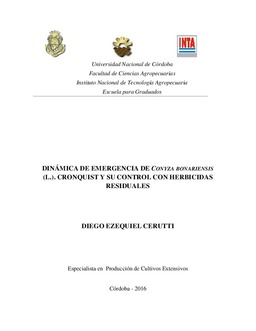| dc.contributor.advisor | Ustarroz, Diego | |
| dc.contributor.author | Cerutti, Diego Ezequiel | |
| dc.date.accessioned | 2016-06-15T17:12:06Z | |
| dc.date.available | 2016-06-15T17:12:06Z | |
| dc.date.issued | 2016 | |
| dc.identifier.uri | http://hdl.handle.net/11086/2721 | |
| dc.description | Trabajo Final (Especialización en Producción de Cultivos Extensivos)--UNC- Facultad de Ciencias Agropecuarias, 2016. | es |
| dc.description.abstract | Conyza bonariensis L. Cronquist (rama negra) es una especie anual de ciclo otoño-inverno-primaveral que se comporta como maleza durante el barbecho, pudiendo estar presente durante el ciclo de los cultivos de verano. Las plantas que emergen durante el otoño y el invierno son difíciles de controlar con herbicidas durante la primavera. Los objetivos de este trabajo fueron i) estudiar la dinámica de emergencia de la maleza rama negra durante el período de barbecho comprendido entre dos cultivos estivales, y ii) evaluar la eficacia de herbicidas residuales con diferente sitio de acción que podrían ser utilizados para su control durante el otoño. Se realizaron experimentos en la Estación Experimental Agropecuaria de INTA Manfredi, Córdoba, Argentina. Los relevamientos de emergencia se llevaron a cabo durante el barbecho en los años 2011 (antecesor soja), 2012 (antecesor soja y maíz) y 2013 (antecesor soja), efectuándose conteos y posterior remoción de las plantas emergidas cada 25 (± 5) días. El experimento de control con herbicidas se aplicó el 3 de mayo de 2013, en un lote con rastrojo de soja. Se evaluó la eficacia de glifosato aplicado solo o en mezcla con diferentes herbicidas residuales a los 20 y 174 días de la aplicación. C. bonariensis emergió durante los meses de marzo a noviembre, con un 80 a 98% de los nacimientos durante otoño e invierno. Dentro de este período, los principales flujos se produjeron hasta fines del mes de junio y primeros días de julio. Durante un mismo año de evaluación, el patrón de emergencia varió según el cultivo antecesor. En lote con antecesor maíz sembrado en octubre la emergencia de la maleza fue temprana, concentrándose durante el mes de marzo, mientras que en lote con antecesor soja la emergencia se produjo principalmente en los meses de abril y mayo. La emergencia de plantas durante la primavera representó del 2 al 20% del total emergido durante el barbecho, siendo en tres de las cuatro situaciones evaluadas menos del 3%. La aplicación de glifosato en otoño redujo en un 75% la densidad de plantas de C. bonariensis durante la primavera. Los tratamientos con sulfonilureas que inhiben la enzima acetolactato sintetasa (metsulfurón, clorimurón y clorsulfurón + metsulfurón), aplicados en la misma fecha, brindaron un control residual superior al 90% en su evaluación en primavera. Atrazina y picloran tuvieron controles del 84 y 85% respectivamente en la misma instancia de evaluación. El resto de los herbicidas residuales brindaron un control menor a 67%. | es |
| dc.description.abstract | Conyza bonariensis L. Cronquist (flaxleaf fleabane) is an annual species of autumn-winter-spring cycle which performs like a weed during the fallow and can be present during the cycle of summer crops. Plants that emerge during autumn and winter are difficult to control with herbicides in the spring. The objectives of this study were i) to study the dynamics of emergence of flaxleaf fleabane during the fallow between two summer crops, and ii) to evaluate the effectiveness of residual herbicides with different site of action which could be used to control during the autumn. Experiments were conducted in the Agricultural Experimental Station of INTA Manfredi, Córdoba, Argentina. The emergency surveys were conducted during the fallow year 2011 (predecessor soybean), 2012 (predecessor soybean and corn) and 2013 (predecessor soybean), performing counts and subsequent removal of plants emerged every 25 (± 5) days. Herbicides were applied on May 3, 2013 in a field with soybean stubble. The effectiveness of glyphosate applied alone or mixed with different residual herbicides was evaluated at 20 and 174 days after application. C. bonariensis emerged from March to November, with 80-98% of the sprouts during autumn and winter. Within this period, the main flows occurred until the end of June early July. In the same year the emergence pattern varied according to the preceding crop. After corn planted in October the emergence of the weed was early, around March, while after soybean the emergence occurred mainly in April and May.
The spring emergence represented 2 to 20% of the total emerged during the fallow, and in three of the four experiences was less than 3%. Glyphosate application on autumn reduced C. bonariensis density by 75% during spring. Treatments with sulfonylureas that inhibit acetolactate synthase enzyme (metsulfurón, chlorimurón and chlorsulfurón + metsulfurón), applied on the same date, provided over 90% residual control in spring evaluation. Atrazine and picloran had 84 and 85% control respectively in the same instance of evaluation. The remaining herbicides had residual control lower than 67%. | en |
| dc.format.extent | 15 h. : gráficos color | |
| dc.language.iso | spa | es |
| dc.rights | Atribución-NoComercial-SinDerivadas 2.5 Argentina | * |
| dc.rights.uri | http://creativecommons.org/licenses/by-nc-nd/2.5/ar/ | * |
| dc.subject | Rama negra | es |
| dc.subject | Emergencia | es |
| dc.subject | Control de malezas | es |
| dc.subject | Barbecho | es |
| dc.subject | Herbicidas | es |
| dc.subject | Efectos residuales | es |
| dc.title | Dinámica de emergencia de Conyza Bonariensis (L.) Cronquist y su control con herbicidas residuales | es |
| dc.type | masterThesis | es |





